Digital Nomad Guide to Living in Koh Lanta
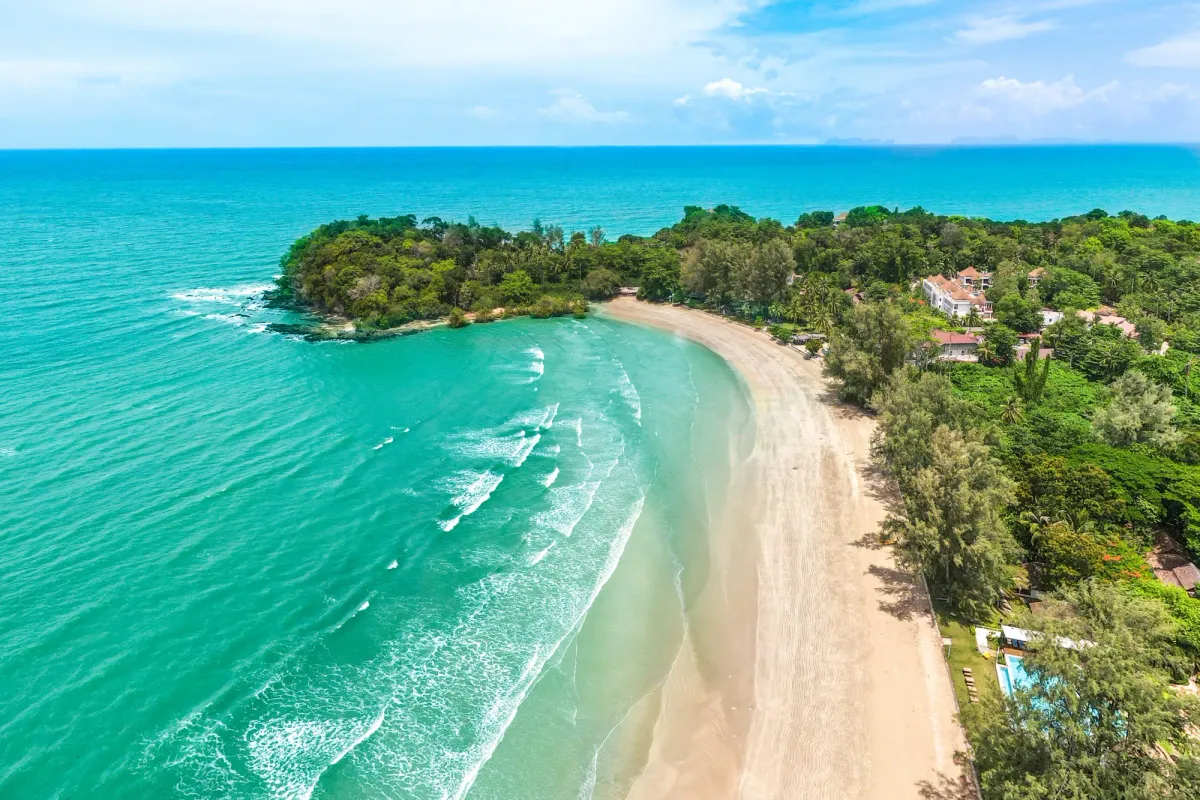
If you're a remote worker looking for a place that balances a peaceful environment with a digital-friendly infrastructure, Koh Lanta could be just the right fit.
Off the coast of mainland Thailand, Koh Lanta is a tranquil island that offers the best of both worlds. It has reliable, high-speed internet and a fantastic tropical coworking space with a great community, making it ideal for digital nomads. Add to that, it's less crowded than other Thai nomad hotspots, making it perfect for those who prefer a quiet, relaxed setting for their remote work lifestyle.
This guide will provide all the information you need about the island's living conditions, places to work from, accommodations, and local culture. Stay tuned if you are considering Koh Lanta as your next remote working destination.
In this guide, we will use Koh Lanta to refer mainly to Koh Lanta Noi, as this is the biggest and most suitable island for digital nomads.
Why Visit Koh Lanta as a Digital Nomad?
Koh Lanta is an attractive destination for digital nomads and remote workers for several reasons:
Reliable internet
As we know, one of the most important factors for a digital nomad is a fast internet connection, and Koh Lanta has that covered. Most cafes, beach bars, and accommodations on the island offer high-speed internet, so you won't have to worry about it.
A vibrant nomad community
Koh Lanta has a great reputation for its awesome digital nomad community, which can provide an excellent opportunity to meet and connect with like-minded people. Its most famous tropical coworking space and the various beach bars on the island are popular gathering spots for digital nomads. We met so many awesome people when we were there, so we are sure it will be the same for you!
It's affordable
Koh Lanta is a very affordable place to live, with low accommodation and food costs, even compared to other Thai islands like Koh Phangan, Phuket or Koh Samui. As a digital nomad, this can be a significant advantage since it allows you to save money, invest in your business, or travel.
Natural beauty
With a diverse range of ecosystems, including rainforests, mangrove forests, and cozy beaches, the island offers plenty of opportunities to explore nature. When we stayed there, being surrounded by nature positively impacted our well-being while reducing stress, and boosting our mood and productivity.
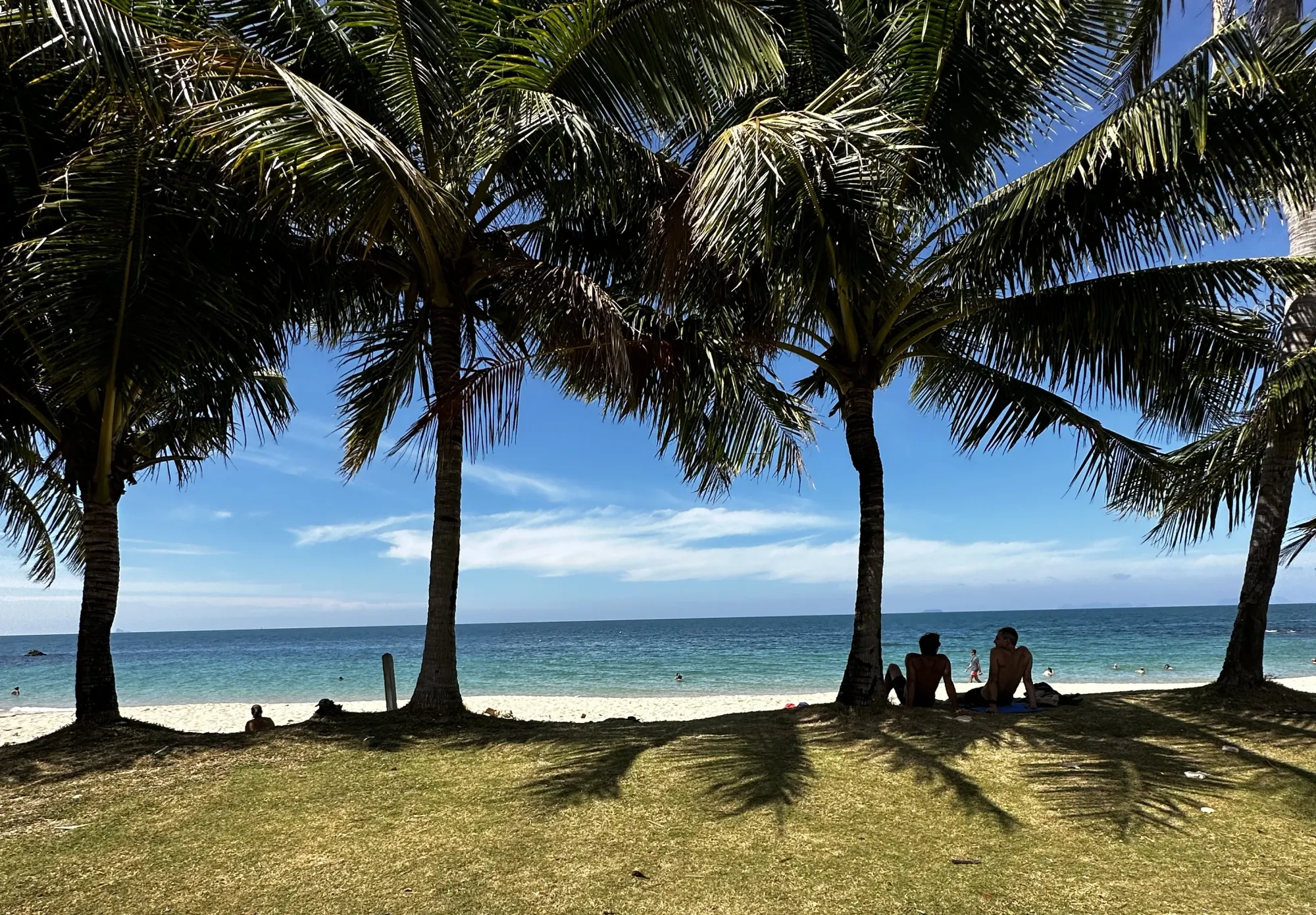
Peaceful atmosphere
Unlike other popular party destinations in Thailand, Koh Lanta is a quieter and more laid-back island. This was the ideal place for us to focus on work and get things done without distractions.
Great base for exploring southern Thailand
Koh Lanta is centrally located and has good transportation connections to other nearby destinations, such as Krabi, Phi Phi Islands, and Phuket. This means we could easily arrange day trips or longer excursions to explore the surrounding areas such as the beautiful islands of Koh Rok and Koh Haa (absolutely recommended!)
How Can I Get To Koh Lanta?
Depending on your starting point and preferences, there are several ways to get to Koh Lanta. Here are some common options we recommend:
From Krabi (Fastest route)
The nearest airport to Koh Lanta is Krabi International Airport. From there you can book the following:
- Ferry – You can take a ferry from Chao Fah pier in Krabi town to Koh Lanta, which takes about 1 hour and 15 minutes and costs between ฿1,100 - ฿1,600 ($30 - $50). There are 21 ferries a week operated by Tigerline Ferry. Other popular ferry companies include Andaman Wave Master and Phi Phi Cruiser.
- Minivan – You can take a minivan from Krabi to Koh Lanta, which takes about 3 hours and can cost around ฿566 ($17). There are hourly departures operated by Krabi Airport Shuttle. There are also several minivan operators that offer services to Koh Lanta, including Ao Nang Travel and Tour and Andaman Taxis.
- Private transfer: You can also take a private transfer from Krabi Airport or your hotel to Koh Lanta, which takes about 90 minutes to 2 hours and costs around ฿3,300 ($96). This option includes a car ride and a ferry crossing.
From Bangkok
Bangkok has two airports: Bangkok’s Don Muang Airport (DMK) and Suvarnabhumi Airport (BKK). Once you get to one of the two airports, you can choose among the following combination of transportation:
- Flight + Minivan and Speedboat transfer (quickest and most convenient way) – You can take a flight from Bangkok’s Don Muang Airport (DMK) or Suvarnabhumi Airport (BKK) to Krabi Airport (KBV), which takes about 1.5 hours and costs from ฿700 ($20.50). Then you can take a minivan and speedboat transfer from Krabi Airport to Koh Lanta, which takes about 3 hours and costs ฿2500 ($73).
- Train + Bus and Ferry (more comfortable way) – You can take a train from Bangkok’s Hua Lamphong Station to Surat Thani Train Station, which takes about 12 hours and costs from ฿500 ($14.50). Then you can take a bus and ferry from Surat Thani Train Station to Koh Lanta, which takes about 6 hours and costs from ฿795 ($23).
- Bus + Ferry (cheapest but more tiring way) – You can take a bus and ferry from Bangkok’s Khao San Road to Koh Lanta’s Saladan Pier, which takes about 15.5 hours and costs from ฿1,000 ($29).
From Phuket
- Ferry: You can take a ferry from Rassada Pier Phuket to Koh Lanta, which takes about 1 hour and 30 minutes and costs between ฿1200 - ฿1700 ($30- $60). There are 3 ferries a day operated by Tigerline Ferry. There is also another ferry from Phuket’s Rassada Pier to Phi Phi Island’s Tonsai Pier, where you can change to another ferry to Koh Lanta’s Sala Dan Pier. The ferry runs every day and takes about 4 hours in total. The price for a one-way ticket is ฿1200 ($30) for standard class, ฿1800 ($50) for first class, and ฿2400 ($70) for premium class
- Speedboat: You can take a speedboat from Rassada Pier Phuket to Saladan Pier Koh Lanta, which takes about 1 hour and 30 minutes and costs ฿1,500 ($45) for adults and ฿1,000 ($30) for children. There are 2 speedboats a day operated by Bundhaya Speed Boat, and that is our recommended speedboat operator because it is slightly cheaper than others. The other operators are Satun Pakbara Speed Boat Club
- Private Transfer: You can also opt for a private transfer from Phuket International Airport or your hotel to Koh Lanta, which takes about 4 hours and costs around ฿3509 ($100). This option includes a car ride and a ferry crossing.
Where To Stay in Koh Lanta
Accommodations in Koh Lanta are generally affordable, and you can expect to rent a bungalow typically from ฿10,000 to ฿25,000 ($300 - $600) per month, depending on your requirements and the level of amenities. Of course, based on your lifestyle, there are also more premium options that offer more comfort and amenities. But let's look at your accommodation options one by one.
Hotels: Our Recommended Option for Daily/Weekly Rentals
You can compare and book accommodations through various online platforms like Booking.com. However, when it comes to many accommodations in Thailand (and most of Asia), the go-to platform for finding good deals is Agoda.
Some of the best hotels for digital nomads in Koh Lanta you might want to consider are:
- Lanta Pearl Beach Resort: A resort that offers free WiFi, bungalows with private balconies, hammocks, and vegetarian-friendly food. It also has a tour desk, a barbecue area, and a beach bar with fire shows and pool tables.
- Beach Home Lanta: A hotel that offers free WiFi, air conditioning, laundry services, and a beachfront location. It also has a restaurant and a bar that hosts live music and fire shows.
- Koh Lanta Sunset Beach Resort: It's a great option for digital nomads who want to be close to the beach. It has a variety of amenities, including a coworking space, high-speed internet, and a pool.
- The Beach House Koh Lanta: It's a relaxed and stylish hotel in Long Beach. It has a great atmosphere for digital nomads, with plenty of places to work and relax.
Bungalow and Guest Houses: Our Recommended Option for Monthly Rentals
Here are some of the best bungalows and guest houses in Koh Lanta to live like a local:
- Lanta Animal Project Bungalows: It's a great option for those who want to stay in a relaxed and laid-back setting. The bungalows are in a quiet area, close to the beach and the Lanta Animal Project, where you can volunteer to help the animals.
- Koh Lanta Hideaway: It's a small, intimate guest house in the heart of Lanta Old Town. It is a great place to meet other fellow travelers and learn more about Thai culture.
- Baan Sabai: It's a family-run guest house located in Long Beach and a great place to relax and enjoy the beach.
- Thara Guesthouse: This is a budget-friendly option located in the heart of Lanta Old Town. It is a great place to meet other travelers and explore the island.
Hostels: Our Budget-Friendly Option
If you have a tight budget or you just want to meet other fellow travelers, you might also consider a hostel. Here are the best hostels in Koh Lanta for digital nomads:
- Hub of Joys Hostel: It's a great option for digital nomads who want to be close to the action. It is located in Saladan, the main town of Koh Lanta, and offers various amenities, including a coworking space, high-speed internet, and a pool.
- Blanco Hostel @Koh Lanta: It's a relaxed and stylish hostel located in Long Beach. It has a great atmosphere for digital nomads, with plenty of places to work and relax.
- Bubu Lanta Hostel: It's a small and intimate hostel located in the heart of Lanta Old Town. It's a good spot to meet other travelers and learn about Thai culture.
- Sweet Life Community Guesthouse: This is a great option for digital nomads who love a chill and relaxed environment. It's in a quiet area, close to the beach and the Lanta Animal Project, where you can volunteer to help the animals.
- Peacock Hostel: It's another great budget-friendly option located in the heart of Lanta Old Town.
Co-living for Digital Nomads
The most popular coliving for digital nomads and remote workers in Koh Lanta is Kohub. They are mainly known for their tropical coworking, but they also offer accommodation with free WiFi, air conditioning, private rooms, and a communal kitchen. It's a good option if you need a place to stay, but also want to enjoy a coworking space with fast WiFi, ergonomic chairs, and social events.
How To Get Around in Koh Lanta
Getting around in Koh Lanta is relatively easy and convenient, and there are several options for transportation:
Rent a Scooter
You can rent a scooter often from your accommodation or a nearby shop, which is the best and most popular way to explore the island. Koh Lanta is quite large and has many attractions in different areas, so having your own scooter will give you more freedom and flexibility. The cost of renting a scooter is around ฿200-300 ($6 - $9) per day.
Take a Tuk-tuk
You can also use a tuk-tuk from your hotel or the main road, which is a convenient way to get to nearby places or beaches. Tuk tuks are easy to find in most areas, especially where there are 7 Eleven stores or other shops. The price for a tuk-tuk ride varies between ฿50 ($1.50) and ฿200 ($5.80), depending on the distance and your bargaining skills.
Songthawes
Songthaews are like small pickup trucks with covered beds, and they're a popular way to get around in Thailand but are not so common in Koh Lanta as people prefer to rent scooters or tuk-tuks. Some songthawes run along the main road from Saladan Pier to the south of the island, but they are not very frequent or reliable. They may also charge higher prices for tourists than locals. So, if you want to get around Koh Lanta with Songthawes, you may have to wait a long time, negotiate the fare, and share the ride with other passengers. It may not be the most convenient or comfortable way to explore the island.
Get on a Boat
If you want to explore the nearby islands, you can take a long-tail boat or speedboat instead. Many of the hotels and tour companies on Koh Lanta offer boat tours, or you can negotiate with a local boat operator (this is our recommended way). The cost will depend on the island you want to explore and your negotiation skills.
Internet Connectivity in Koh Lanta
When it comes to the internet connection, Koh Lanta, fortunately, doesn't disappoint. The island has significantly improved its digital infrastructure over the past few years, offering reliable high-speed internet to both locals and digital nomads.
Most accommodations, cafes, and beach bars provide free Wi-Fi, which is usually sufficient for general remote work tasks. However, for digital nomads who require stable and faster internet connections for video calls, file transfers, and other demanding tasks, head to our 'Places to Work From' section to see which ones are the best. The coworking spaces we will mention typically have backup power and internet connections to ensure uninterrupted productivity.
However, as with any location, there can be occasional internet outages, especially in the wet monsoon season. Therefore, it's advisable to have a contingency plan in place, such as a local SIM card with a data package or an eSIM, which can act as a backup during any unforeseen internet interruptions. Let's look at which options you have in the next sections. When it comes to local SIM cards Thailand has three main prepaid/tourist SIM card providers: AIS, DTAC, and TrueMove. You can buy them at the airport, in convenience stores like 7Eleven or Family Mart, or Tesco Lotus Express or from mobile shops or stalls that sell phones and accessories.
If you want to make sure you get internet even before you enter Thailand and you want to avoid queues or worse scams, you have the option to opt for an eSIM. It's a virtual SIM that doesn't require to be physically inserted or removed from your phone and good eSIM providers we recommend for Thailand are Airalo, Holafly and Jetpac.
Best Places to Work From in Koh Lanta as a Digital Nomad
Whether it's a coworking space, a cozy cafe, or even a beach bar where you can work with a view of the ocean, Koh Lanta has many options.
Best Coworking Space in Koh Lanta
- KoHub – This is the most popular and established coworking space in Koh Lanta, and it's located near Long Beach. It has a spacious and tropical setting with fast and reliable internet, a "zen zone" with a little waterfall, air-conditioned rooms, open-air decks, a restaurant and cafe where you can order from their app, and, above all, a very strong digital nomad community. It also offers various packages and events for members, such as board game nights, community lunches, sunset drinks, and day trips.
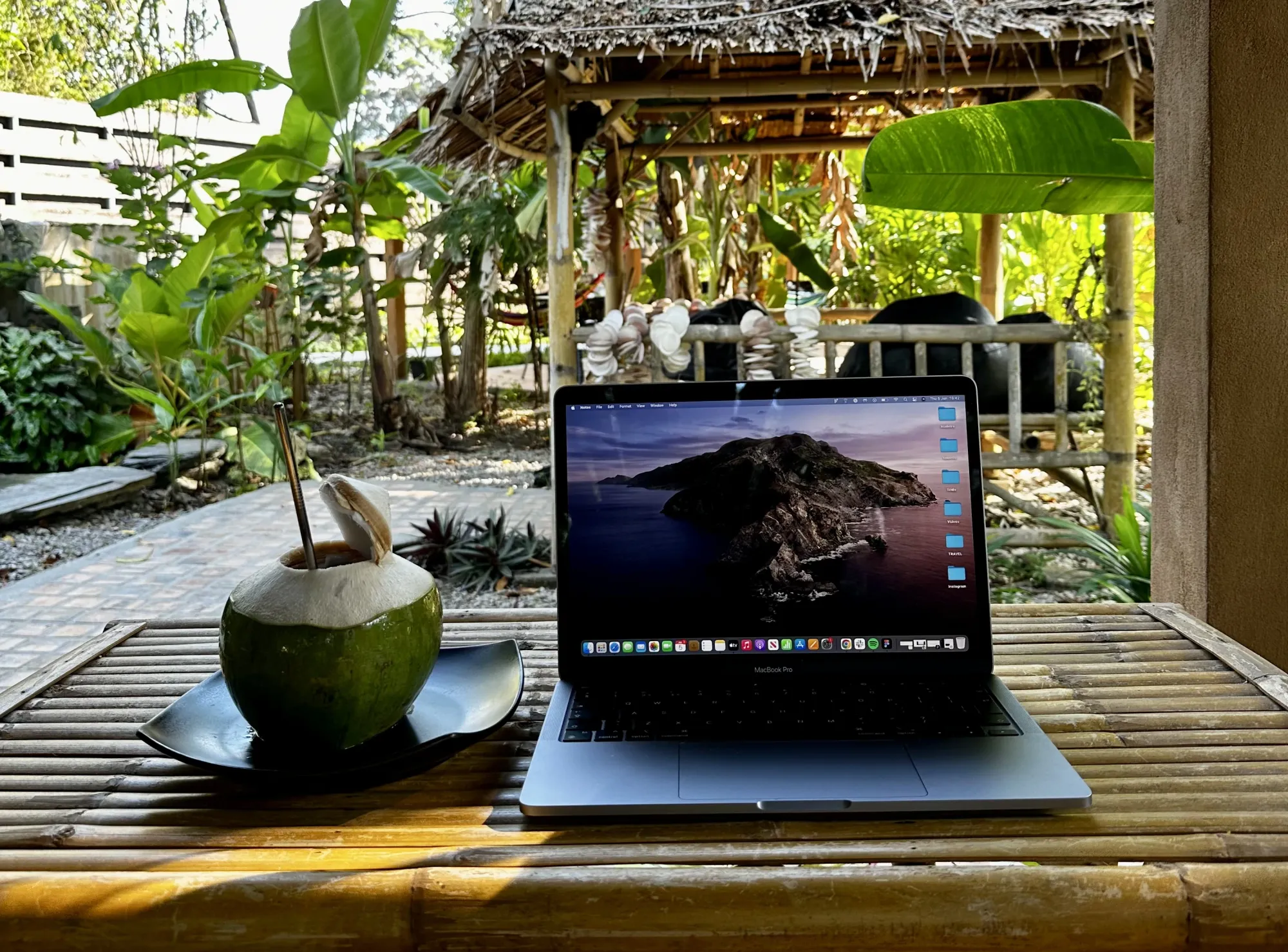
Best Laptop-Friendly Cafes and Beach Bars in Koh Lanta
- Lym's Bar – This is a laid-back and lively beach bar and restaurant that serves cocktails, beers, spirits, and Thai food. It has good internet, floor cushions on colorful rugs, live music, and fire shows on Friday nights. It also has a stunning view of the sea and the stars. It is located near Phra Ae Beach (also known as Long Beach) in Ko Lanta Yai, and it's our favorite place to work in the morning, just in front of the beach!
- The Living Room Cafe & Bakery – It's a charming and rustic cafe in Klong Dao Beach that serves fresh bread, pastries, cakes, coffee, tea, and juices. It has good internet, cozy furniture, books, magazines, and board games. It also has a lovely garden and a relaxing atmosphere. Sometimes it can be a bit crowded, especially in the morning, so if you are looking for a quiet place it might not be for you.
- Smoon Cafe – It's a cozy and modern cafe in Koh Lanta that serves delicious coffee, smoothies, cakes, sandwiches, salads, and fusion dishes and it's located near Ban Klongtoab in Ko Lanta Yai. It has decent free WiFi, comfortable seating, power outlets, and friendly staff. It also has a nice view of the garden and the sea, and it's overall a good place to work from in Koh Lanta if you are looking for a relaxing and nourishing atmosphere. It is open from Monday to Sunday from 8:00 AM to 4:00 PM, except on Wednesdays when it is closed.
- Lanta Coffee Cup Club – This is another cozy and modern cafe in Phra Ae Beach (also known as Long Beach) that serves delicious coffee, smoothies, cakes, sandwiches, and salads. It has fast and reliable internet, power outlets, and friendly staff. When we went there, it was pretty empty, so it's great if you are looking for a place to get some work done without much noise.
Cost of Living in Koh Lanta as a Digital Nomad
As we often mentioned in this guide, one of the most attractive aspects of Koh Lanta for digital nomads is its relatively low cost of living compared to other popular remote work destinations, including many islands in Thailand. We actually found Koh Lanta to be one of the cheapest islands in Thailand to work from. This tropical island's affordability makes it a standout choice for those keen to balance work, travel, and budget.
Whether it's a budget guesthouse to live in like a local or a more comfortable hotel, housing tends to be inexpensive.
Eating out is also affordable, with local Thai meals costing around ฿100-200 ($3-6) at street food stalls, while Western meals at restaurants might range from ฿250-500 ($7-14).
Local transportation, primarily scooter rentals, is cost-effective as well, with monthly rentals ranging from ฿4,000-5,000 a month ($120-150).

Coworking spaces offer a range of membership options, from daily to monthly, generally ranging from ฿400 for a day pass to around ฿6,500 for a monthly membership.
Visa Options and Digital Nomad Visa for Koh Lanta
Thailand has recently launched its own digital nomad visa, but there are also many promising initiatives on the horizon.
An option digital nomads working in the tech sector could consider is the Smart S (Startup) visa. This visa could permit a stay of up to four years without a work permit, subject to meeting criteria such as possessing a bachelor’s degree, earning a minimum monthly salary of ฿200,000 ($5.800), and having a health insurance policy.
Other types of visas digital nomads who want to work remotely in Thailand may consider are:
- Tourist visa – Allows a stay of up to 60 days with an extension option for an additional 30 days. Repeated renewals or re-entry might be challenging with this visa, which doesn't allow for work or business activities.
- Thai Elite visa – Allows for a lengthy stay of up to 20 years based on the chosen package, but it comes with a hefty price tag, ranging from ฿600,000 to ฿2 million ($17.500 to $58,000). It also doesn't permit any form of work or business activities in the country.
- Business visa – Allows a stay of up to 90 days per entry with an extension option for up to 1 year. This visa necessitates sponsorship from a Thai organization or company able to provide a work permit. This may not be suitable for digital nomads working for themselves or overseas clients.
How is the Nightlife in Koh Lanta?
As we said a few times in this guide, Koh Lanta is an island in Thailand that has a laid-back and relaxed culture. It is not as busy or noisy as other popular destinations, but it still offers some nightlife options for those wanting fun.

Some of the best places to enjoy drinking and nightlife in Koh Lanta are:
- Why Not Bar: A beachfront hang-out with fire twirlers, live music, and cocktails.
- Pangea: A chill-out bar with thatch-roofed cabanas, floor cushions, and a sandy floor.
- Irie: A reggae Rasta bar with live bands, floor cushions, and a friendly vibe.
- Funky Monkey: A lively bar with pool tables, darts, live music, and sports screens.
- Cheeky Monkey Bar: Yeah, we know, a lot of monkey places in Koh Lanta (lol). This bar is close to the Kohub coworking so you will often find that the nomad crowd moves there from time to time.
- Irish Embassy: A pub with quiz nights, sports screens, pool competitions, and Guinness on tap. This is a bit more international, and you will find a lot of expats there.
What's the Best Time To Visit Koh Lanta as a Digital Nomad?
Koh Lanta's diverse seasons offer different but equally enticing opportunities for digital nomads, allowing you to choose the best fit for your lifestyle and work rhythm.
If you thrive in lively environments and can work with the bustle of tourists around you, the High Season (November to December) and Peak Season (January to February) bring stunning weather and calm seas. However, costs can be a little bit higher.
On the other hand, if a quieter, less crowded atmosphere fuels your productivity, the Low Season (March to April) offers warmth, fewer tourists, and reduced prices. All these months we just mentioned are part of the Dry Monsoon season, so as per the name, they are pretty sunny and dry.

We would honestly avoid the Wet Monsoon season (May to October). Although its lush nature and significantly lower costs could be attractive, you would be working around rainy weather as Koh Lanta will be directly exposed to the Indian Ocean and the storms and rainfall that come with it. Sadly, during this time, a lot of trash washes up on the beaches from the ocean. People try to clean it up, but it's hard because it keeps coming for 6 months straight. The sea becomes hard to swim in because of bad visibility and big waves, and you would also have limited activities as most businesses tend to shut down due to the low number of tourists coming to visit the island.
Is Koh Lanta Safe To Visit?
Koh Lanta is generally considered safe to visit. Like many other Thai tourist destinations, it has a low crime rate, and tourists usually experience trouble-free visits. You will soon realize how the locals are super friendly and welcoming to visitors.
As for natural hazards, Koh Lanta, like other coastal areas in Thailand, can experience heavy rains and storms, especially during the monsoon season (May to October). Visitors during this time should be cautious of rough seas and rip currents when swimming.
It's also important to be careful when driving or riding scooters on the island, as traffic accidents can occur due to poor road conditions or unfamiliarity with local driving habits.
Best Things To See and Do in Koh Lanta as a Digital Nomad
With its mix of natural beauty, cultural experiences, and opportunities for relaxation and adventure, Koh Lanta is a place that seamlessly blends work and leisure, allowing you to make the most of your digital nomad experience.
Here are some things you can do during your off-hours:
1. Explore Lanta's Beaches
Koh Lanta boasts several stunning beaches, each with its unique charm. From the popular Long Beach to the serene Bamboo Beach, Ao Nui Bay, and Beautiful Beach, plenty of sandy stretches exist to relax, swim, or catch a sunset after a productive workday.

2. Visit Mu Ko Lanta National Park
The Mu Ko Lanta National Park is a fantastic way to break from work and reconnect with nature. The park offers beautiful trails, a stunning lighthouse, and opportunities to spot diverse wildlife.
3. Explore the Old Town
Koh Lanta's Old Town, with its wooden stilt houses and quiet streets, offers a glimpse into the island's history and culture. It's a great place to stroll during your time off!
3. Try Snorkeling in Koh Rok and Koh Haa
If you want to enjoy an amazing day off in one of the most crystal-clear waters we have ever seen, book a day trip to the islands of Koh Rok and Koh Haa and check out the vibrant coral reefs around Koh Lanta. Trust us, you won't regret it.
4. Experience the Local Cuisine
Indulge in a cooking class or simply explore the local markets and beachside restaurants to savor the flavors of Thai cuisine.
5. Join a Yoga Class
Numerous yoga studios around the island offer classes that give you a chance to balance your work schedule.
Are You Ready To Live and Work in Koh Lanta?

Join our global
digital nomad community
Join us for free
Freaking Nomads is supported by you. Clicking through our links may earn us a small affiliate commission, and that's what allows us to keep producing free, helpful content. Learn more



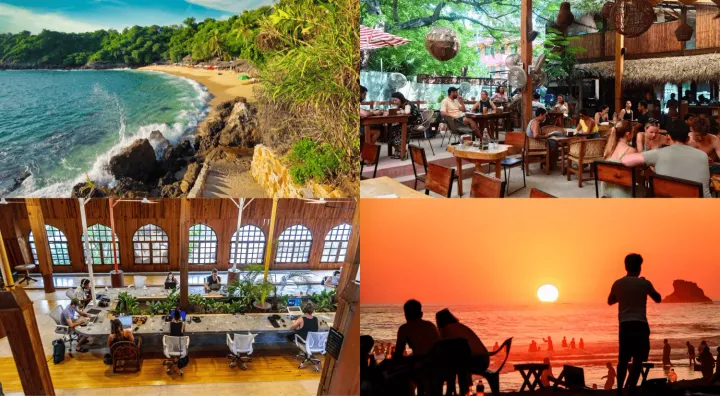
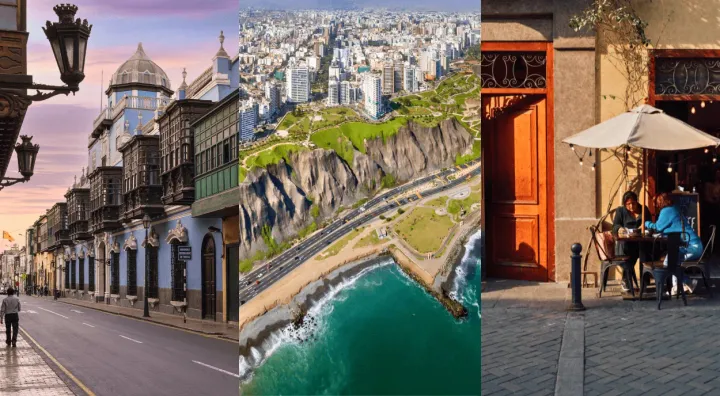
 Travel tips, hacks, and news
Travel tips, hacks, and news Exclusive travel discounts
Exclusive travel discounts Offers and promotions
Offers and promotions Digital nomad inspiration
Digital nomad inspiration Latest articles form our blog
Latest articles form our blog